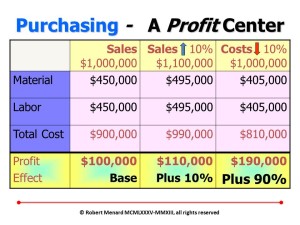How Do Folks Arrive at a Purchasing Career?

Robert Menard
Certified Purchasing Professional,
Certified Professional Purchasing Consultant, Certified Green Purchasing Professional, Certified Professional Purchasing Manager
I began doing education and training seminars almost two decades ago. It was a great proving ground for sharpening public speaking skills. The American Management Association recruited me to write and deliver a Negotiation program. It must have been good as it is still in use today at the seminar company which bought out the Kansas City subsidiary.
Since I was a purchasing expert, they also asked me to write and deliver a two day Purchasing program. Since my style was energetic and zany , my resemblance to Mel Brooks was a daily comment which I took as a complement. I liked to open with humor – not a joke, but more of a caricature. One of my favorite opening gambits was to ask the groups, which ranged between 25 and 100, this spoof question, for which I demanded a show of hands. “How many of you, when you were young, grew up dreaming that when you got big, you were going to be a purchasing manager?” There were chuckles and guffaws. On very rare occasions throughout the 2,000 or so seminars I have done, someone would raise their hand; I think they were spoofing me!
I would then go on to tell them that purchasing was the Rodney Dangerfield of business. Despite the fact that purchasing represents 90% of operations for a firm that earns 10%, and that purchasing is the most efficient and largest generator of profitability in all of business, “I tell ya we just get no respect.”
Then I would ask them how they got to purchasing. Many were accounts payable clerks, some were engineering and technical types, a few had business backgrounds, and still others had done well at something else. In all cases, their reward for their success was a sentence to purchasing. There was general resentment and disregard of purchasing because the internal customer did not understand or appreciate what value purchasing brought to business. Attendees would volunteer that coworkers thought that anyone could do purchasing. “What’s the big deal? Just get three prices, do the bump and grind, and off in a cloud of smoke!” Yeah, just like that.
I am proud and happy that the view of procurement has changed. Leadership from within the profession is largely responsible for its own ringing successes. One of the economic facts in our favor is what I previously contended, that purchasing is the most efficient and largest generator of profitability in all of business. Let me prove it to you.
 The table to the right shows the effect of both purchasing and sales on profitability. There are two ways to increase profits; increase sales or decrease costs.
The table to the right shows the effect of both purchasing and sales on profitability. There are two ways to increase profits; increase sales or decrease costs.
Assume a business grosses one million per year. It is scale-able for 10 million, 100 million, etc. For simplicity the components of sales are Material and Labor shown in the first column. In each of the next three columns, add those two together to compute the Total Cost. Subtract the Total Cost from the Sales to compute the Profit in the bottom row. The Effect line in the bottom row shows the impact on savings.
The second column is the Base. We will measure results compared to the Base. The third column shows the effect of increasing sales by 10%. Material and Labor rise a proportional 10% (neglecting minimal savings from leverage). The net effect is a 10% increase in Profit.
But now, look what happens when Costs are reduced by 10%. Material and Labor drop by the proportional 10%. The net effect is a whopping 90% increase in profitability! There is no razzle-dazzle here. It is straight forward economics and arithmetic.
So the next time someone asks you about why you have a career in purchasing, tell them the straight forward truth. You want to have the greatest impact on the organization’s profitability. I am with you.